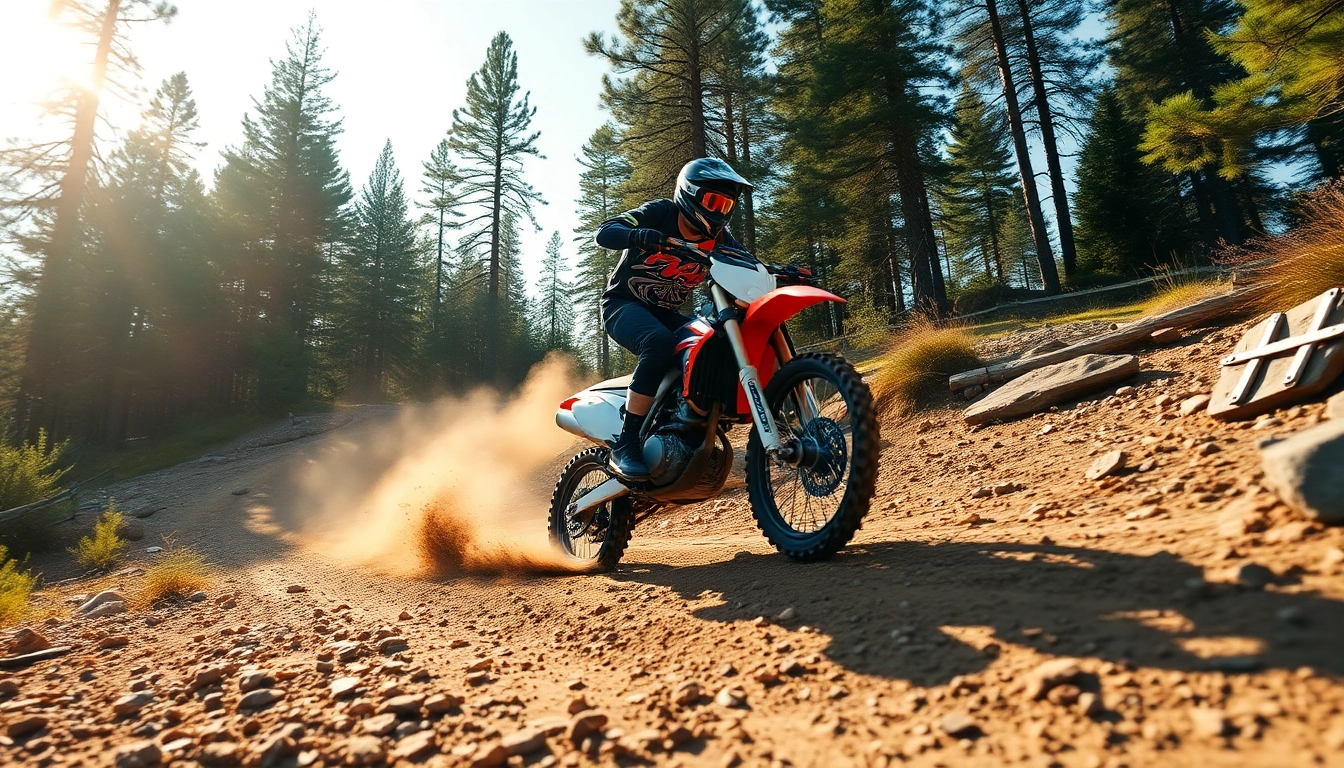Understanding Dirt Bike Singletrack
Dirt biking is a thrilling experience, and one of the most exhilarating aspects of this sport is riding on dirt bike singletrack. Singletrack trails are narrow, winding paths that offer riders the chance to immerse themselves in the great outdoors while testing their skills. In this article, we delve deep into the world of dirt bike singletrack, covering everything from its defining characteristics to the best riding techniques and safety precautions.
Defining Singletrack Trails
The term “singletrack” refers to a specific type of trail that is typically only wide enough for one rider at a time. This narrow path can be found in various environments, ranging from forests to deserts. Unlike multi-use trails, singletrack is designed primarily for hiking or biking and often features tighter turns, obstacles, and natural terrain, making it both challenging and exhilarating for riders. The narrowness of the trail often leads to a more immersive experience with the surrounding nature, allowing riders to connect with the environment in a unique way.
Key Characteristics of Dirt Bike Singletrack
Dirt bike singletrack trails possess several distinctive characteristics that differentiate them from other types of trails. These include:
- Narrow Width: As mentioned, singletrack trails are typically just wide enough for a single bike, which creates a sense of solitude and adventure.
- Technical Challenges: Riders encounter rocky paths, roots, steep climbs, and sharp descents. This requires precise handling and technique.
- Variety of Terrain: The surface can vary widely—from sandy stretches to muddy areas and rocky obstacles—contributing to a diverse riding experience.
- Natural Obstacles: Trees, boulders, and other natural elements may obstruct the path, adding to the excitement and requiring riders to navigate skillfully.
- Scenic Routes: Most singletrack trails are located in beautiful, unspoiled regions, providing riders with stunning views and an immersive experience.
Importance of Trail Maintenance
Maintaining singletrack trails is crucial for both safety and sustainability. Proper maintenance helps to:
- Preserve the Environment: By preventing erosion and damage to the terrain, maintenance ensures that trails can be enjoyed for years to come.
- Enhance Safety: Regular maintenance checks can identify and remedy safety hazards such as fallen trees or washouts.
- Facilitate Accessibility: Well-maintained trails are more accessible to riders of different skill levels, inviting a wider audience to enjoy dirt biking.
- Promote Wildlife Health: Proper trail management can reduce the impact on natural habitats, allowing wildlife to thrive.
Essential Riding Techniques for Dirt Bike Singletrack
Mastering the art of riding on dirt bike singletrack requires a combination of technique, practice, and confidence. Below are essential riding techniques for navigating these complex trails effectively.
Body Positioning for Tough Terrain
Body positioning is crucial when riding singletrack. Proper positioning allows for better balance and control over the bike. Key points include:
- Stand on the Pegs: Riding in a standing position helps absorb shocks and maintain balance on uneven terrain.
- Loose Grip: Keep a relaxed grip on the handlebars to better handle shifts in bike traction.
- Lean Forward: Shifting your weight forward during climbs offers better traction and control.
- Look Ahead: Focus on where you want to go, not just the obstacles directly in front of you. This proactive approach will help you maintain your path.
Throttle Control on Narrow Trails
Throttling is a critical skill for navigating tight corners and technical sections effectively. Consider these tips:
- Gradual Acceleration: Smoothly apply the throttle during turns to avoid losing traction.
- Use Engine Braking: In addition to your brakes, modulating throttle can help you slow down efficiently on downhill sections.
- Practice Precise Inputs: Training yourself to use gradual throttle inputs can improve control, especially in tricky sections.
Effective Braking Strategies
Knowing when and how to apply brakes is vital on singletrack trails. Here are strategic tips:
- Front and Rear Brake Balance: Utilize both brakes simultaneously for maximum stopping power while maintaining control.
- Progressive Braking: Start braking lightly before a turn, then apply additional brake pressure as needed, rather than slamming on the brakes.
- Practice Emergency Stops: Regularly practice stopping quickly in a controlled environment to ensure preparedness on the trail.
Safety Considerations While Riding Dirt Bike Singletrack
Safety should always be a top priority for riders venturing into the world of dirt bike singletrack. Here are key considerations to keep in mind.
Wearing Proper Gear
Investing in the right safety gear can significantly reduce the risk of injury. Essential gear includes:
- Helmet: A DOT-approved helmet protects against head injuries.
- Body Armor: Chest protectors, knee guards, and elbow guards mitigate impact protection.
- Boots: Adequate riding boots should provide ankle protection and a firm grip on the bike.
- Gloves: Good quality gloves enhance grip and comfort while controlling the bike.
Understanding Trail Etiquette
Respecting other trail users is an essential aspect of trail riding. Follow these etiquette rules:
- Yielding Right of Way: Give space to hikers and bikers faster than you. Consider the type of trail users to determine who yields.
- Stay on Designated Trails: To minimize environmental impact, always ride on designated trails and avoid cutting new paths.
- Keep Noise Down: Excessive noise can disturb wildlife and other trail users.
Preparing for Emergencies
Being prepared for emergencies while on the trail is crucial. Consider these preparatory measures:
- First Aid Kit: Carry a lightweight first aid kit tailored for off-road riding.
- Communication Device: Have a cellphone or GPS device for emergency contact, especially when riding in remote areas.
- Know Basic Survival Skills: Familiarize yourself with survival skills, such as navigation and first aid techniques.
Finding Popular Dirt Bike Singletrack Trails
Discovering new and exciting dirt bike singletrack trails contributes to enhancing the thrill of your riding experience. Here are ways to find popular trails.
Prominent Trails in the U.S.
Some of the most well-known dirt bike singletrack trails in the U.S. include:
- Alpine Loop, Colorado: Known for its stunning views and challenging terrain, this trail is favored by seasoned riders.
- Manistee National Forest, Michigan: This area boasts an extensive network of singletrack with varying difficulty levels.
- Tahoe National Forest, California: Featuring diverse trails that cater to different skill levels, it’s a must-ride location for dirt biking enthusiasts.
Utilizing Trail Maps and Apps
With the advent of technology, trail maps and mobile applications have streamlined the process of locating dirt bike singletrack trails. Some popular tools include:
- Trailforks: This app provides comprehensive trail maps and user reviews, helping riders find optimal routes.
- AllTrails: While primarily designed for hikers, this app includes many dirt bike trails and user-generated content.
- OnX Offroad: This navigation app offers offline maps to support trail finding in remote areas.
Community Recommendations for Hidden Gems
The dirt biking community often shares insider knowledge about lesser-known trails that deserve exploration. Engaging on platforms like forums, social media groups, and riding clubs can unearth hidden gems that may not be listed on conventional trail maps.
Enhancing Your Skills on Dirt Bike Singletrack
Improving your skills is an ongoing journey for any dirt bike rider. Here are strategies to elevate your abilities on dirt bike singletrack.
Practicing with Simulated Obstacles
Setting up practice areas with obstacles can significantly enhance your skills in navigating complex trails. Consider incorporating:
- Plywood ramps: These can simulate logs encountered on trails.
- Cones: Use cones to practice tight turns and maneuverability.
- Hills: Create small hills for practicing climbs and descents safely.
Joining Riding Clinics and Workshops
Participating in riding clinics led by experienced instructors can offer invaluable insights, personalized feedback, and structured learning. Consider looking for:
- Local motorcycle clubs: Many clubs host training sessions and workshops.
- Motorcycle schools: These institutions often offer comprehensive courses that cover the technical aspects of riding and safety.
Setting Personal Riding Goals
Establishing specific, measurable goals can help guide your improvement efforts. Goals can include:
- Mastering specific techniques: Set targets for skills like cornering, braking, and climbing.
- Increasing endurance: Determine a distance or riding time commitment to build your stamina.
- Participating in events: Sign up for local races or charity rides to challenge yourself and gain experience.



